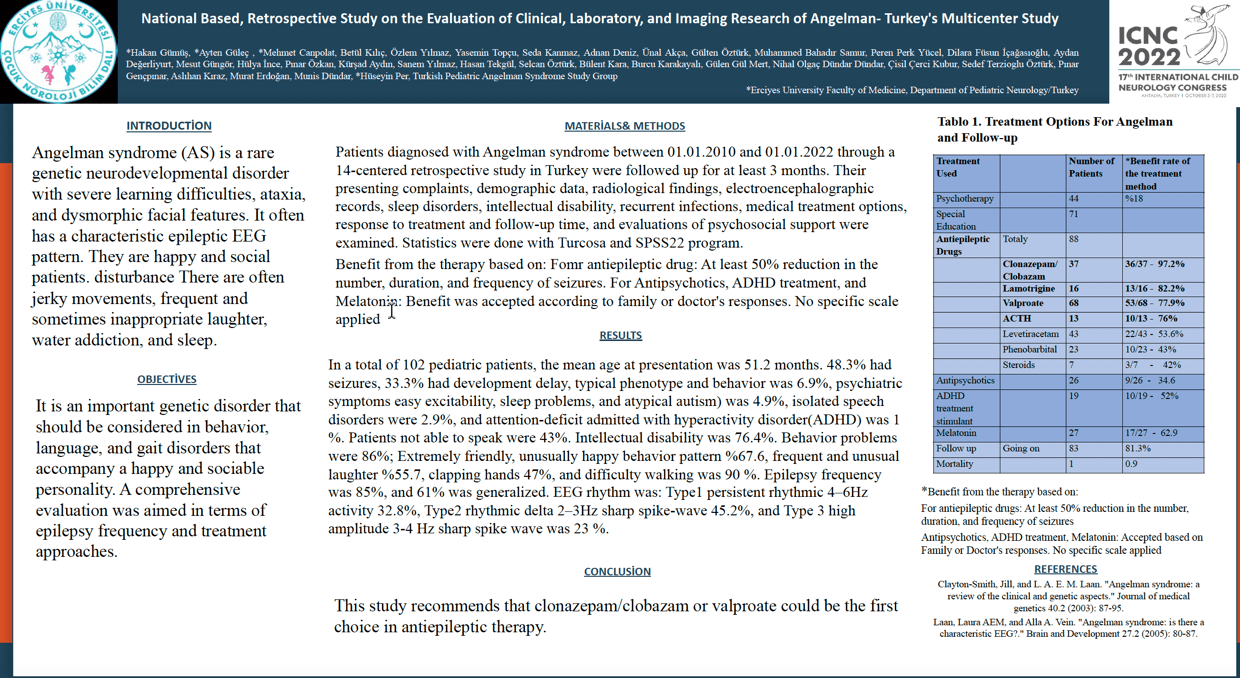National Based, Retrospective Study on the Evaluation of Clinical, Laboratory, and Imaging Research of Angelman Syndrome- Turkey's Multicenter Study
Hakan Gümüş, Ayten Güleç , Mehmet Canpolat, Betül Kılıç, Özlem Yılmaz, Yasemin Topçu, Seda Kanmaz, Adnan Deniz, Ünal Akça, Gülten Öztürk, Muhammed Bahadır Samur, Peren Perk Yücel, Dilara Füsun İçağasıoğlu, Aydan Değerliyurt, Mesut Güngör, Hülya İnce, Pinar Ozkan, Kürşad Aydın, Sanem Yılmaz, Hasan Tekgül, Selcan Öztürk, Bülent Kara, Burcu Karakayalı, Gülen Gül Mert, Nihal Olgaç Dündar Dündar, Çisil Çerci Kubur, Sedef Terzioglu Öztürk, Pinar Gençpinar, Aslıhan Kıraz, Murat Erdoğan, Munis Dündar, Hüseyin Per, Turkish Pediatric Angelman Syndrome Study Group
Angelman syndrome (AS) is a rare genetic neurodevelopmental disorder with severe learning difficulties, ataxia, and dysmorphic facial features. It often has a characteristic epileptic EEG pattern. They are happy and social patients. There are often jerky movements, frequent and sometimes inappropriate laughter, water addiction, and sleep disturbance. Patients diagnosed with Angelman syndrome between January 2010 to January 2022 through a 17 centered retrospective study in Turkey were followed up for at least 3 months. Their presenting complaints, demographic data, radiological findings, electroencephalographic records, sleep disorders, intellectual disability, recurrent infections, medical treatment options, response to treatment and follow-up time, and evaluations in terms of psychosocial support were examined.
In a total of 102 pediatric patients, the mean age at presentation was 51.2 months. 48.3% seizures, 33.3% psychomotor retardation, 6.9% typical phenotype and behavior patterns, 2.9% speech disorders, psychiatric symptoms, easy excitability, sleep problems, and atypical autism, 6.9% attention-deficit admitted with hyperactivity disorder(ADHD). While not being able to speak at all was 43%, dysfunctional speaking was 35%. Intellectual disability was 76.4%. Behavior problems were 86%; Extremely friendly, unusually happy behavior pattern %67.6, frequent and unusual laughter %55.7, clapping hands 47%, difficulty walking was 90 %. Epilepsy frequency was 85%, and 61% was generalized. EEG rhythm was: Type1 persistent rhythmic 4–6Hz activity 32.8%, Type2 rhythmic delta 2–3Hz sharp spike-wave 45.2%, and Type 3 high amplitude 3-4 Hz sharp spike wave23 %.
It is an important genetic disorder that should be considered in behavior, language, and gait disorders accompanying a happy and social personality.
Keywords: epilepsy, angelman, speech disorders, difficulty walking
Hakan Gümüş
Erciyes University Faculty of Medicine, Department of Pediatric Neurology
Turkey
Ayten Güleç
Erciyes University Faculty of Medicine, Department of Pediatric Neurology
Mehmet Canpolat
Erciyes University Faculty of Medicine, Department of Pediatric Neurology
Betül Kılıç
Medipol University Faculty of Medicine, Department of Pediatric Neurology
Özlem Yılmaz
Medipol University Faculty of Medicine, Department of Pediatric Neurology
Yasemin Topçu
Medipol University Faculty of Medicine, Department of Pediatric Neurology
Seda Kanmaz
Ege University Faculty of Medicine, Department of Pediatric Neurology
Adnan Deniz
Kocaeli University Faculty of Medicine, Department of Pediatric Neurology
Ünal Akça
Samsun Training and Research Hospital, Department of Pediatric Neurology
Angelman syndrome (AS) is a rare genetic neurodevelopmental disorder with severe learning difficulties, ataxia, and dysmorphic facial features. It often has a characteristic epileptic EEG pattern. They are happy and social patients. There are often jerky movements, frequent and sometimes inappropriate laughter, water addiction, and sleep disturbance. Patients diagnosed with Angelman syndrome between January 2010 to January 2022 through a 17 centered retrospective study in Turkey were followed up for at least 3 months. Their presenting complaints, demographic data, radiological findings, electroencephalographic records, sleep disorders, intellectual disability, recurrent infections, medical treatment options, response to treatment and follow-up time, and evaluations in terms of psychosocial support were examined.
In a total of 102 pediatric patients, the mean age at presentation was 51.2 months. 48.3% seizures, 33.3% psychomotor retardation, 6.9% typical phenotype and behavior patterns, 2.9% speech disorders, psychiatric symptoms, easy excitability, sleep problems, and atypical autism, 6.9% attention-deficit admitted with hyperactivity disorder(ADHD). While not being able to speak at all was 43%, dysfunctional speaking was 35%. Intellectual disability was 76.4%. Behavior problems were 86%; Extremely friendly, unusually happy behavior pattern %67.6, frequent and unusual laughter %55.7, clapping hands 47%, difficulty walking was 90 %. Epilepsy frequency was 85%, and 61% was generalized. EEG rhythm was: Type1 persistent rhythmic 4–6Hz activity 32.8%, Type2 rhythmic delta 2–3Hz sharp spike-wave 45.2%, and Type 3 high amplitude 3-4 Hz sharp spike wave23 %.
It is an important genetic disorder that should be considered in behavior, language, and gait disorders accompanying a happy and social personality.
Keywords: epilepsy, angelman, speech disorders, difficulty walking
Hakan Gümüş
Erciyes University Faculty of Medicine, Department of Pediatric Neurology
Turkey
Ayten Güleç
Erciyes University Faculty of Medicine, Department of Pediatric Neurology
Mehmet Canpolat
Erciyes University Faculty of Medicine, Department of Pediatric Neurology
Betül Kılıç
Medipol University Faculty of Medicine, Department of Pediatric Neurology
Özlem Yılmaz
Medipol University Faculty of Medicine, Department of Pediatric Neurology
Yasemin Topçu
Medipol University Faculty of Medicine, Department of Pediatric Neurology
Seda Kanmaz
Ege University Faculty of Medicine, Department of Pediatric Neurology
Adnan Deniz
Kocaeli University Faculty of Medicine, Department of Pediatric Neurology
Ünal Akça
Samsun Training and Research Hospital, Department of Pediatric Neurology

Ayten Güleç
Erciyes University Faculty of Medicine, Department of Pediatric Neurology
Erciyes University Faculty of Medicine, Department of Pediatric Neurology